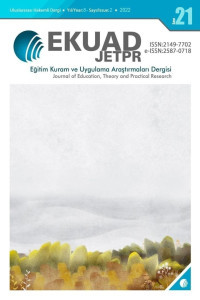STEM Uygulamalarına Yönelik Öğretmen Görüşlerinin İncelenmesi
Research on Teacher Opinions on STEM Practices
STEM, Teacher, Qualitative,
___
- Alumbaugh, K. M. (2015). The Perceptions of Elementary STEM Schools in Missouri. (Unpublished doctoral dissertation). Lindenwood University, Missouri.
- American Institute of Physics. (2015). President Obama on STEM education. Retrieved May 2017, https://www.aip.org/fyi/2015/president-obama-stem-education.
- Banks, F., & Barlex, D. (2014). Teaching STEM in the secondary school: How teachers and schools can meet the challenge. London: Routledge.
- Cantrell, P., Pekca, G., & Ahmad, I. (2006). The effects of engineering modules on student learning in middle school science classrooms. Journal of Engineering Education. 95(4), 301-309.
- Capraro, R. M., Capraro, M. M., & Morgan, J. (Eds.). (2013). Project-based learning: an integrated science, technology, engineering, and mathematics (STEM) approach (2nd ed.). Rotterdam: Sense.
- Creswell, J.W. (2003). Research design: Qualitative, quantitative, and mixed methods approaches. Thousand Oaks, CA: Sage.
- Dass, P.M. (2015). Teaching STEM effectively with the learning cycle approach. K- 12 STEM Education. 1(1), 5-12.
- Evans, E. M. (2015). Preparıng Elementary Pre-Servıce Teachers to Integrate STEM: A Mıxed-Methods Study. Doctor of Educatıon. Northern Illinois University, Illinois.
- Dugger, W. E. (2010). Evolution of STEM in the united states. the 6th Biennial International Conference on Technology Education Research. (8-11 December), Gold Coast, Queensland, Australia.
- Felix, A., & Harris, J. (2010). A project-based, STEM integrated: Alternative energy team challenge for teachers. The Technology Teacher. 69(5), 29-34.
- Glesne, C. (2014). Nitel araştırmaya giriş (A. Ersoy & P. Yalçınoğlu, Çev.). Ankara: Anı Yayıncılık. Gonzalez, H. B. & Kuenzi, J. J. (2012). science, technology, engineering and mathematics (STEM) education: A Primer. Congressional Research Service. Retrieved Jule 2017, https://www.fas.org/sgp/crs/misc/R42642.pdf. Han, S., Capraro, R., & Capraro, M. M. (2014). How science, technology, engineering, and mathematics (STEM) project-based learning (PBL) affects high, middle, and low achievers differently: The impact of student factors on achievement. International Journal of Science and Mathematics Education. 13(5), 1089-1113.
- Haynes, M.M., & Santos, A.D. (2007). Effective teacher professional development: Middle school engineering content. International Journal of Engineering Education. 23(1), 24-29.
- Hynes, M. M. (2008). Middle-school teachers’ use and development of engineering subject matter and pedagogical content knowledge: a pilot study. (Unpublished doctoral dissertation). Tufts University, Medford.
- Kabaran, G. G. & Uşun, S. (2017). Eğitim fakültesi öğrencilerinin fakülte ve öğretim elemanı kavramlarına ilişkin metaforları. Eğitim Kuram ve Uygulama Araştırmaları Dergisi. 3(2), 35-49.
- Kennedy, M. M., S. Ahn & J. Choi (2008) The value added by teacher education. In M. Cochran-Smith, S. Feiman-Nemser, and J. McIntyre (Editors). Handbook of research on teacher education: enduring issues in changing contexts (pp. 1249-1273) Mahwah, NJ: Lawrence Erlbaum Associates, Inc.
- Milli Eğitim Bakanlığı. (2016). STEM eğitim raporu. Ankara: Yenilik ve Eğitim Teknolojileri Genel Müdürlüğü.
- Morrison, J. (2006). TIES STEM education monograph series, attributes of STEM education. Baltimore, MD: TIES.
- Ostler, E. (2012). 21st century STEM education: a tactical model for long-range success. International Journal of Applied Science and Technology. 2(1), 28-33.
- Partnership for 21st Century Skills. (2009). Framework for 21st century learning. Retrieved July 2017, www.21centruryskills.org. Selvi, M. & Yıldırım, B. (2017). STEM öğretme-öğrenme modelleri: 5e öğrenme modeli, proje tabanlı öğrenme ve STEM SOS modeli. S. Çepni (Ed.). Kuramdan Uygulamaya STEM+A+E Eğitimi (s.203-236). Ankara: Pegem.
- Shulman, L. S. (1986). Those who understand: Knowledge growth in teaching. Educational Researche., 15(2), 4–14.
- Stohlmann, M., Moore, T., & Roehrig, G. H. (2012) Considerations for teaching ıntegrated STEM education. Journal of Pre-College Engineering Education Research (J-PEER). 2(1).
- Sözer, E. (2008). Eğitimin felsefi temelleri. M. Gültekin (Ed.). Eğitim bilimine giriş içinde (s. 57-75). Eskişehir: Anadolu Üniversitesi Yayınları.
- Teaching Institute for Excellence in STEM (2010). What is STEM education?. Retrieved March 2017, http://www.tiesteach.org/stem-education.aspx.
- Yıldırım, B. & Altun, Y. (2014). STEM eğitimi üzerine derleme çalışması: Fen bilimleri alanında örnek ders uygulanmaları. VI. International Congress of Education Research (5-8 Haziran), Ankara, Türkiye.
- Yıldırım, B. (2017a). Fen eğitiminde STEM. M. P. Demirci Güler (Ed.). Fen Bilimleri Öğretimi (s. 283-295). Ankara: Pegem Akademi.
- Yıldırım, B. (2017b). Bilim merkezleri ve STEM. A. Güney (Ed.). Her Yönüyle Bilim Merkezi: Bilim Merkezlerine Dair Kavramsal Bir Okuma (s. 207-220). Konya: Çizgi Kitapevi.
- Yıldırım, B., (2016). 7. Sınıf fen bilimleri dersine entegre edilmiş fen teknoloji mühendislik matematik (STEM) uygulamaları ve tam öğrenmenin etkilerinin incelenmesi. (Yayınlanmamış doktora tezi). Gazi Üniversitesi, Ankara.
- Wang, H. H., Moore, T. J., Roehrig, G. H., & Park, M. S. (2011). STEM integration: Teacher perceptions and practice. Journal of Pre-College Engineering Education Research (J-PEER). 1(2), 2.
- Zollman, A. (2012). Learning for STEM literacy: STEM literacy for learning. School Science and Mathematics. 112(1), 12-19.
- ISSN: 2149-7702
- Yayın Aralığı: Yılda 3 Sayı
- Başlangıç: 2015
- Yayıncı: Sabri SİDEKLİ
Öğretmen Adaylarının Yabancı Dil Sınıfında Ana Dili Kullanma Biçimleri: Bir Vaka İncelemesi
Ortaöğretime Geçiş Sistemi ile İlgili “Fen Bilimleri Öğretmeni Görüş Ölçeği” Geliştirme Çalışması
Öğretmenlerin Örgütsel Adalet ve Örgütsel Kimlik Algıları Arasındaki İlişkinin İncelenmesi
Sinematografik Anlatıda Okuldaki İletişim Ağları: Ron Clark’ın Hikâyesi Filmi Örneği
Bilgisayar ve Öğretim Teknolojileri Öğretmen Adaylarının Eğitsel Mobil Uygulamalara Yönelik Algıları
Liselerde Öğretmene Yönelik Şiddetin Çeşitli Değişkenler Açısından İncelenmesi: Niğde İli Örneği
İlkokulda Model Oluşturma Etkinlikleri Nasıl Uygulanmalı?
STEM Uygulamalarına Yönelik Öğretmen Görüşlerinin İncelenmesi
Öğretim Lideri Olmanın Anlamına İlişkin Fenomenolojik Bir Araştırma
